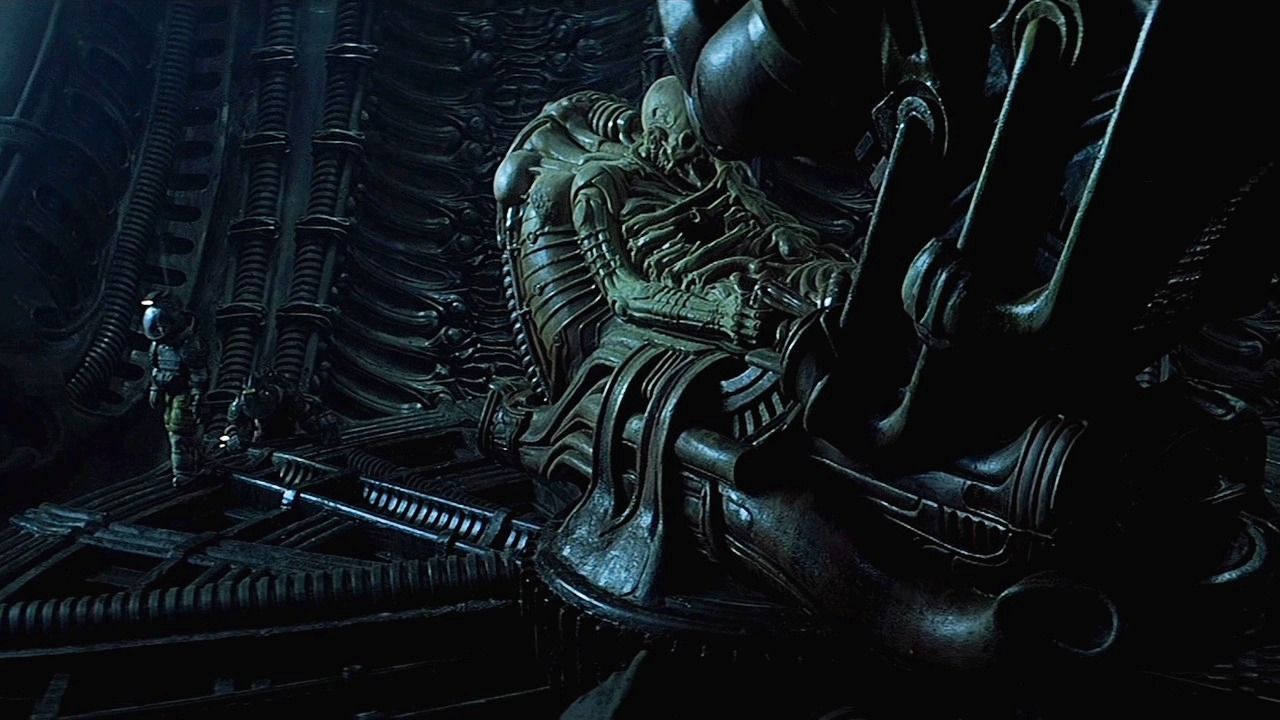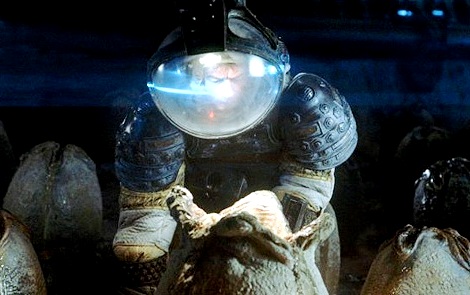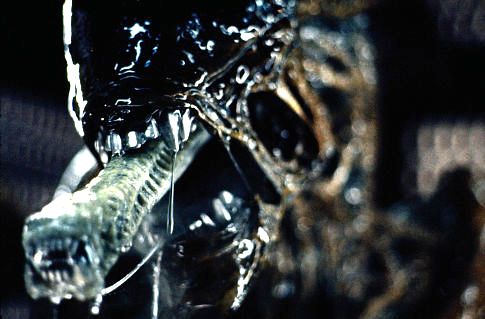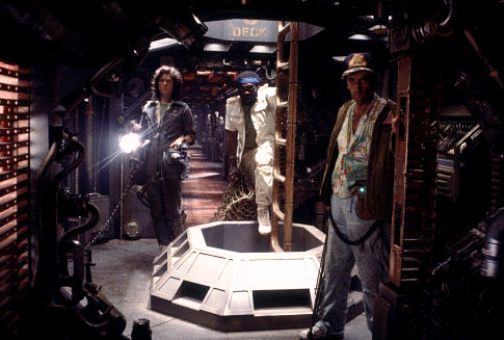
“In Space No One Can Hear You Scream”
One of the classics in shuddering claustrophobia scenarios with a monster on the loose. I implore you to see Alien (1979) before the new summer blockbuster “Prometheus” comes out, a prequel that will precede events of the Alien series. It’s dated in exactly two ways, and visionary and durable in limitless others. The original cast included Harry Dean Stanton, Ian Holm, John Hurt, Sigourney Weaver, Tom Skerritt, Veronica Cartwright and Yaphet Kotto. The director is Ridley Scott, who went on to make “Blade Runner” (1982), “Gladiator” (2000) and “Black Hawk Down” (2001). “Prometheus,” opening June 8th, will be his first return to directing an entry in the sci-fi saga since the original.
The computer screens with the green lettering is outdated – it would have been better if Scott never showed you any screens. The computers, with “Mother” as the operating and interactive hard drive, must have looked “futuristic” at the time. Also, the commercial spacecraft “Nostromo” has too many unnecessary buttons and thingamajigs on the walls that don’t look like they are used for anything.
 That’s it when it comes to gripes. Though I’m not sure that last one is even worth griping about. What I admire about Scott though is how he put in all this hardware in the background that mystifies us. He has placed a crew of refinery contractors in the middle of it, most of them bummed by their work conditions. They want to go back to Earth, but they are sidetracked to go survey a planet. We see a humongous cadaver of an alien lifeform – consider that it might have been a non-violent lifeform. There is an atmosphere of post-destruction, so we consider there must be a destructive, violent species in the vicinity. One crew member is lowered down a hatch and finds green mist layered on a field of ominous eggs. One of them hatches, then springs onto the crew member’s helmet and as a parasite eats through the helmet and attaches onto his face.
That’s it when it comes to gripes. Though I’m not sure that last one is even worth griping about. What I admire about Scott though is how he put in all this hardware in the background that mystifies us. He has placed a crew of refinery contractors in the middle of it, most of them bummed by their work conditions. They want to go back to Earth, but they are sidetracked to go survey a planet. We see a humongous cadaver of an alien lifeform – consider that it might have been a non-violent lifeform. There is an atmosphere of post-destruction, so we consider there must be a destructive, violent species in the vicinity. One crew member is lowered down a hatch and finds green mist layered on a field of ominous eggs. One of them hatches, then springs onto the crew member’s helmet and as a parasite eats through the helmet and attaches onto his face.
To bring the man with an attached crab-octopus thing onboard would be an act of breaking quarantine, according to Ripley (Weaver). Her orders are disregarded, and the injured man is brought aboard. Ash (Holm), the chief scientist officer, is intently curious about the circumstances and has plans to lock-box the creature so it can be returned to Earth for the merits of science and research. The crab-octopus thing sheds its skin and disappears to morph into something else. If you’ve never seen “Alien,” then I’m not going to tell you what happens next. I hope I whet your appetite by telling you that electric prods and flamethrowers are no match for it. The creature designer who worked on the film was H.R. Gigor whose self-proclaimed vocational title in life was “Swiss Surrealist.” It’s a perfect creature because it has an impervious defense mechanism to persist survival.
 “Alien” continues to be timelessly effective because of the hysteria that Scott invokes. He does this by creating mood within the set decoration which is suffocating, cold and labyrinthian in form. He doesn’t cut his film up into jagged little pieces. Instead by allowing his long shots to breathe, the mood is able to envelop you like vapor. I think the movie is supercool to look at (watch it in the dark, with an icy drink in hand. Really, to maximize your enjoyment, just do it). It’s sweaty and dank at times, appropriate for this being a blue-collar expedition. The camera glides in a way that is both stirring and goosing – you start watching out for every turned corner.
“Alien” continues to be timelessly effective because of the hysteria that Scott invokes. He does this by creating mood within the set decoration which is suffocating, cold and labyrinthian in form. He doesn’t cut his film up into jagged little pieces. Instead by allowing his long shots to breathe, the mood is able to envelop you like vapor. I think the movie is supercool to look at (watch it in the dark, with an icy drink in hand. Really, to maximize your enjoyment, just do it). It’s sweaty and dank at times, appropriate for this being a blue-collar expedition. The camera glides in a way that is both stirring and goosing – you start watching out for every turned corner.
The genre is Horror, but it’s much more than horrifying. Once you’ve seen “Alien” a couple of times you become jaded that it’s no longer as horrifying. But it always remains interesting, because good sci-fi is interesting. For starters, the seven crew members don’t all love each other. You see the tolerance wear down as the stakes get more intense. Parker (Kotto), the jubilant black guy, is the most likeable of all the characters – he is the jester and peacemaker. He’s not afraid though to say though that the situation is bull****.
There’s the issue that the crew is being used for collateral damage by an Earth corporation that is willing to put human lives at risk in the name of space exploration. If the company cared more about these people, they would have supplied them with an interstellar spaceship that came with more of that cool leather padding on the walls in every room and corridor. On a good night, you can’t stop thinking about this stuff. There’s no escape really for anyone, since the crew is helplessly drifting out in the endless outreaches of the galaxy. Outer space is the ultimate abyss.
Scott’s box office smash – grossing $104 million in 1979 dollars – was followed by “Aliens” (1986), by director James Cameron, which abandoned the isolation and suspense approach in favor of action roller-coaster thrills, nevertheless tops for its genre. Then came David Fincher’s “Alien 3” (1992) which I’d call an interesting misfire, it doesn’t add much to the series as it should have but it has some good things in it. “Alien: Resurrection” (1997) was a geek show, a witless dead-end. “Prometheus” is a good fresh start.
Film Cousins: “The Thing” (1982); “Aliens” (1986); “Alien 3” (1992); “Alien: Resurrection” (1997).






